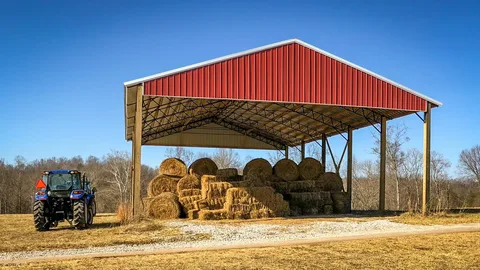
When it comes to farming, storing hay properly isn’t just convenient—it’s essential. Moisture, sunlight, and pests can ruin your hay supply faster than you think. That’s where a well-built hay barn comes in. It’s one of the most cost-effective ways to safeguard your hard work and maintain the value of your feed.
In this post, we’ll break down the benefits of hay barns in Cedar Bluff AL, why they matter more than ever for modern landowners, and how investing in one can save you money and stress in the long run.
Why a Hay Barn Is Essential
Hay might seem low maintenance once it’s baled, but improper storage leads to waste, mold, and even fire hazards. A quality hay barn keeps your feed dry, allows proper airflow, and helps you stack and manage your supply efficiently.
Here’s what a dedicated hay storage barn can do for you:
-
Prevent Moisture Damage: Rain, humidity, and condensation can quickly spoil hay if it’s exposed.
-
Avoid Sun Bleaching: Constant UV exposure robs hay of nutrients.
-
Keep Pests Away: Elevation and enclosed walls help deter rodents and birds.
-
Fire Safety: Proper stacking and ventilation reduce the risk of spontaneous combustion.
-
Organized Inventory: Know exactly how much hay you have and where it is at all times.
Whether you’re feeding cattle, horses, or other livestock, your hay is too valuable to risk.
Different Hay Barn Styles
Choosing the right style depends on your needs, property layout, and budget. Common hay barn types include:
-
Open-Sided Pole Barns: Great for ventilation, with partial enclosure.
-
Fully Enclosed Barns: Maximum protection from weather and pests.
-
Loafing Sheds: Ideal for small farms or dual-purpose animal shelter and hay storage.
-
Gambrel Roof Barns: Offer more vertical space for stacking large amounts.
Customization is key. The right builder will tailor the barn to your hay capacity, loading/unloading methods, and future expansion plans.
Why Hay Barns Make Sense in Cedar Bluff, AL
Cedar Bluff, AL, with its rich agricultural roots and open farmland, is an ideal location for hay production and livestock. But it also comes with its fair share of humid days, thunderstorms, and unpredictable weather—all of which can compromise stored hay.
A dedicated hay barn in Cedar Bluff gives local farmers a solid edge. Not only does it protect feed, but it also helps streamline operations and preserve profits during seasons when hay costs rise.
Whether you run a small family farm or a larger operation, having your hay protected means fewer losses, better quality feed, and peace of mind year-round.
Choosing the Right Builder
While DIY kits exist, working with an experienced barn builder ensures the structure meets local codes, stands up to Alabama’s weather, and fits your specific needs.
Benefits of hiring a pro:
-
Custom sizing and design for your hay storage volume
-
Knowledge of local zoning and permitting requirements
-
Durable materials suited to regional climate
-
Quick, safe construction without cutting corners
The right builder will help you design a barn that lasts for decades and grows with your operation.
Conclusion
Investing in a hay barn is more than just protecting feed—it’s about protecting your bottom line. Whether you’re managing a small herd or operating a full-scale farm, a well-built hay barn in Cedar Bluff, AL offers a lasting solution to one of farming’s biggest challenges: reliable, year-round hay storage.
Don’t wait until a downpour ruins your latest haul. Build smart, store safe, and make your farm more efficient than ever.
FAQs
1. How much hay can a standard barn hold?
It depends on size and stacking method, but a medium barn can store 100–300 large bales.
2. Does hay need to breathe?
Yes. Good airflow is critical to prevent mold and spontaneous combustion.
3. Can hay barns be used for equipment too?
Absolutely. Many farmers design multipurpose barns to store both hay and machinery.
4. Are hay barns worth the investment?
Definitely. The cost of lost or spoiled hay adds up quickly—proper storage pays for itself.
5. What’s the best foundation for a hay barn?
Gravel is common, but concrete pads work well too, especially for heavy stacking and equipment use.Home improve